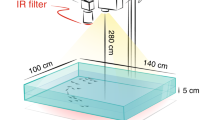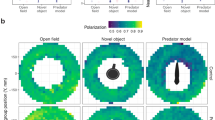Abstract
The orientational behaviour of the neritic mysid Neomysis mirabilis in a swarm is considered under natural and experimental conditions. In nature, the swarms exhibit elements of inner integration, such as homogeneous age structure, collective behaviour, and relative constancy of inter-individual spacing. The mysids are guided by combined optomotor and vibrotactile cues, determining their disposition in aquaria of different shapes. Maximum accuracy of spatial arrangement is observed in round vessels. It is suggested that the stress encountered in an aquarium produces responses comparable to those elicited by the presence of a predator. The rigid spatial arrangement at the supra-individual level is interpreted as evolutionally-optimized prey strategy. These elements in the geometrical distribution of individuals in mysid swarms are inherent in other pelagic crustaceans also, and are not controlled by random taxes stimulated by hydrological factors.
Similar content being viewed by others
Literature Cited
Allen, J. A.: The surface swarming of Polybius henslovi (Brachiura: Portunidae). J. mar. biol. Ass. U.K. 48, 107–111 (1968).
Butorina, L. G.: Some peculiarities of behaviour of Polyphemus pediculus L. (Cladocera). [In Russ.]. In: Materials of the first symposium on behaviour of aquatic invertebrates, Borok, 1971. pp 31–38. borok: Nauka 1972.
Chirkova, Z. N.: On “family” groupings of Ilyocriptus (Cladocera, Macrothricidae). [In Russ.]. In: Materials of the first symposium on behaviour of aquatic invertebrates, Borok, 1971. pp 147–149. Nauka 1972.
Clutter, R. I.: The microdistribution and swarming behaviour of pelagic mysids. [In Russ.]. In: Second international oceanographical congress, Preprints of reports, 199 pp. Moscow: Nauka 1966.
—: The microdistribution and social behaviour of some pelagic mysid shrimps. J. exp. mar. Biol. Ecol. 3, 125–155 (1969).
Cushing, D., H. Jones and F. R. Harden: Why do fish school? Nature, Lond. 218 (5145), 918–920 (1968).
Della Croce, N.: Considerazioni su Polybius henslovi Leach (Crustacea: Brachiura). Boll. Musei Ist. biol. Univ. Genova 31, 5–13 (1961).
— and L. B. Holthuis: Swarming in Charybdis (Goniohellenus) edwardii Leene et Buitendijk in the Indian Ocean (Crustacea: Decapoda, Portunidae). Boll. Musei Ist. biol. Univ. Genova 33, 33–38 (1965).
Emery, A. R.: Preliminary observations on coral reef plankton. Limnol. Oceanogr. 13, 293–303 (1968).
Fager, E. W. and R. I. Clutter: Parameters of a natural population of a hypopelagic marine mysid, Metamysidopsis elongata (Holmes). Physiol. Zoöl. 41, 257–267 (1968).
Hermann, S. S.: Spectral sensitivity and phototaxis in the opossum shrimp, Neomysis americana Smith. Biol. Bull. mar. biol. Lab., Woods Hole 123, 562–570 (1962).
—: Vertical migration of the opossum shrimp, Neomysis americana Smith. Limnol. Oceanogr. 8, 228–238 (1963).
Herrnkind, W. F.: “Queuing” behaviour of spiny lobster. Science, N.Y. 164 (3886), 1425–1427 (1969).
—: Migration of the spiny lobster. Nat. Hist., N.Y. 79, 36–43 (1970).
Losse, G. F. and H. R. Merrett: The occurrence of Oraiosquilla investigatoris (Crustacea: Stomatopoda) in the pelagic zone of the Gulf of Aden and the equatorial western Indian Ocean. Mar. Biol. 10, 244–253 (1971).
Macquart-Moulin, C.: Les comporteent d'essaime chez les mysidacés—observation et analyse de quelques essaims littoraux. Rapp. P.-v. Réun. Commn int. Explor. scient. Mer Méditerr. 20, 439–441 (1971).
— et C. Patriti: Remarque sur la biologie d'Hemimysis speluncola Ledouer, mysidacé sciaphila des grottes sousmarines obscures de région de Marseille. Recl. Trav. Stn mar. Endoume 56, 253–258 (1966).
Mauchline, J.: Seasonal occurrence of Mysidacea (Crustacea) and evidence of social/behaviour. J. mar. biol. Ass. U.K. 51, 809–827 (1971).
Moran, S.: Ecology of distribution of the sand-dwelling mysid Gastrosaccus sanctus (Van-Beneden, 1961) along the Mediterranean sandy shore of Israel. Crustaceana 1972 (Suppl. 3), 357–301 (1972).
Nicol, J. A. C.: Studies on luminescence. Attraction of animals to a weak light. J. mar. biol. Ass. U.K. 38, 477–479 (1959).
Radakov, D. V.: The schooling of fishes as an ecological phenomenon, [In Russ.]. 172 pp. Moscow: Nauka 1972.
Steven, D. M.: Shoaling behaviour in a mysid. Nature, Lond. 191 (4799), 280–281 (1961).
Vilenkin, B. J. and M. J. Vilenkina: Water oscillations caused by the activity of marine bottom invertebrates. [In Russ.]. Dokl. Akad. Nauk SSSR 196, 214–216 (1971).
Vine, I.: Risk of visual detection and pursuit by a predator and the selective advantage of blocking behaviour. J. theor. Biol. 30, 405–422 (1971).
Watermann, T. H.: Interaction of polarized light and turbidity in the orientation of Daphnia and Mysidium. Z. vergl. Physiol. 43, 149–172 (1960).
— (Ed.): The physiology of Crustacea, Vol. 2. 681 pp. New York, London: Academic Press 1961.
Witt, P. N., C. F. Reed and D. B. Peakall: A spider's web (Problem in regulatory biology), 105 pp. Berlin-Heidelberg-New York: Springer-Verlag 1968.
Zelickman, E. A.: The behaviour pattern of the Barents Sea Euphausiacea and possible causes of seasonal vertical migrations. Int. Revue ges. Hydrobiol. 46, 276–281 (1961).
Zelickman, E. A.: An attempt on a neuropharmacological analysis of the behaviour of mysids (Crustacea). (In preparation).
— and A. N. Golovkin: Composition, structure and productivity of neritic plankton communities near the bird colonies of the Northern Shores of Novaya Zemlya. Mar. Biol. 17, 265–274 (1972).
Author information
Authors and Affiliations
Additional information
Communicated by M. E. Vinogradov, Moscow
Rights and permissions
About this article
Cite this article
Zelickman, E.A. Group orientation in Neomysis mirabilis (Mysidacea: Crustacea). Mar. Biol. 24, 251–258 (1974). https://doi.org/10.1007/BF00391900
Accepted:
Issue Date:
DOI: https://doi.org/10.1007/BF00391900




